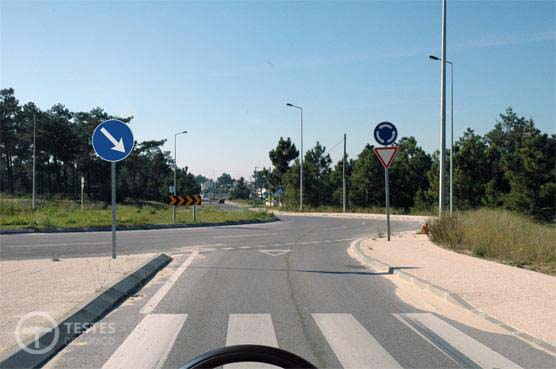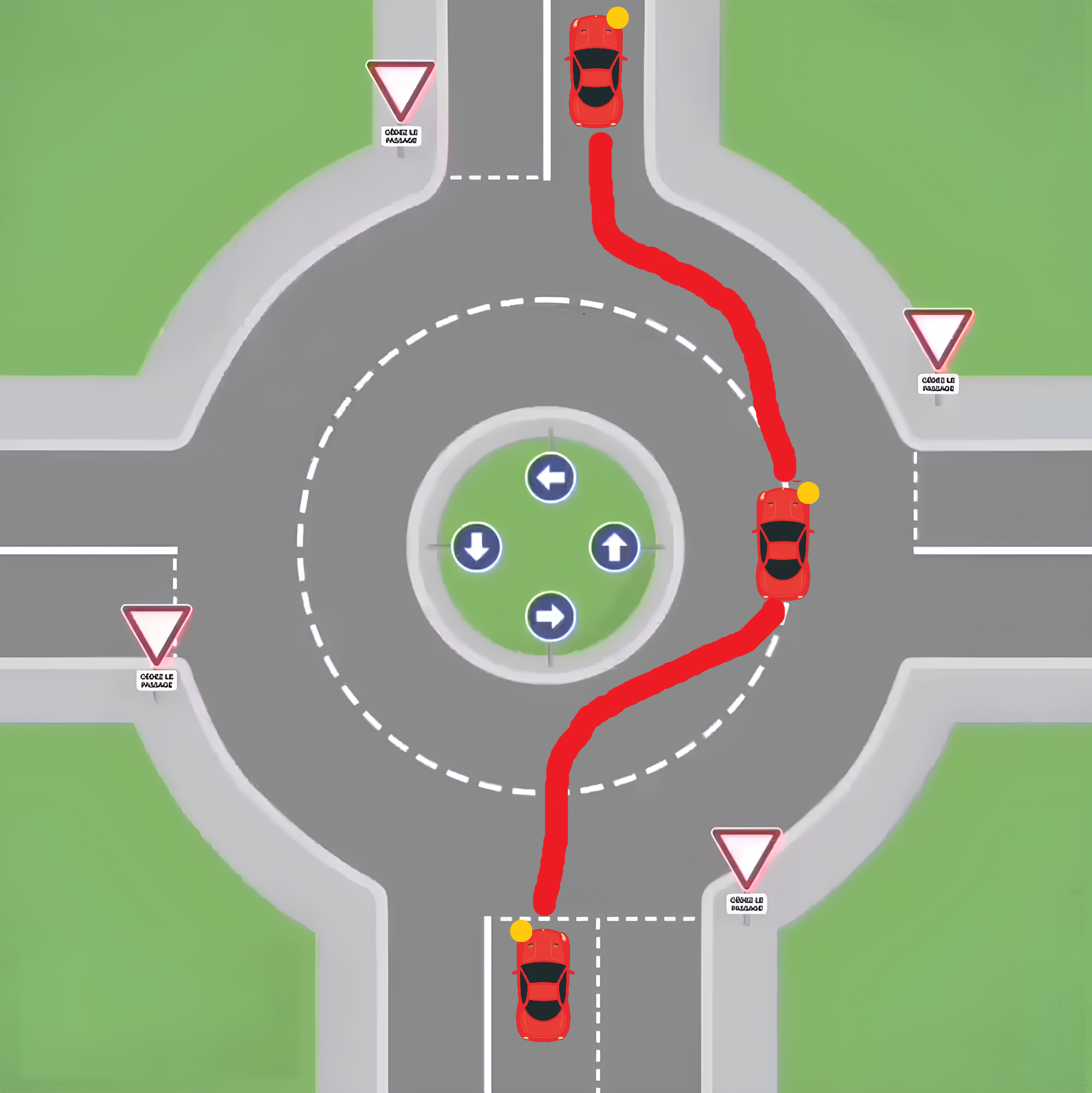Roundabouts

Roundabouts in Portugal — Complete Guide
Understanding Article 14-A of the Portuguese Highway Code
📖 Definition
"A roundabout is an area formed by intersections or junctions where traffic moves in a circular direction and is signalled as such."
Roundabouts help manage traffic flow in locations with high vehicle volume. They generally feature a circular "O" shape design that facilitates continuous movement and reduces congestion at busy intersections.
🚦 Roundabout Traffic Signals
Signal 1: Approaching Roundabout

Meaning: You are approaching a roundabout. Reduce speed and prepare to give way to vehicles already circulating.
Action: Slow down, check mirrors, and be ready to stop if necessary.
Signal 2: Roundabout Ahead

Meaning: Roundabout is directly ahead. You must follow roundabout rules and give priority to vehicles from your right.
Action: Give way to vehicles already on the roundabout. Choose correct lane based on your exit.
Article 14-A (Roundabouts) was added to the Highway Code, approved by Decree-Law 114/94 of 3 May, published in the Official Gazette of 3 September 2013 that came into force on 1 January 2014. This legislation established clear rules for navigating roundabouts in Portugal, significantly improving traffic flow and safety.
📘 Article 14-A — Roundabouts
1 - At roundabouts, drivers must behave as follows:
- a) Enter the roundabout after giving way to vehicles travelling on it, regardless of which way they are travelling;
- b) If they want to leave the roundabout in the first exit lane, they must take the right-hand lane;
- c) If you want to leave the roundabout via any of the other exit lanes, you must only take the rightmost traffic lane after passing the exit lane immediately before the one you want to leave, progressively approaching it and changing lanes after taking the necessary precautions;
- d) Without prejudice to the provisions of the previous paragraphs, drivers must use the traffic lane most convenient to their destination.
2 - Drivers of animal or animal-drawn vehicles, cyclists and heavy goods vehicles may use the traffic lane furthest to the right, without prejudice to their duty to give way to drivers travelling under the terms of paragraph 1(c).
3 - Anyone infringing the provisions of paragraphs 1(b), (c), and (d), and 2 shall be penalised with a fine of €60 to €300.
🔄 Roundabout Examples from Driving Tests
Here are some examples of roundabouts that commonly appear in driving theory tests:

Question 471: Standard two-lane roundabout

Question 3549: Multi-exit urban roundabout

Question 1847: Complex intersection roundabout

Question 556: Rural area roundabout
Click on images to enlarge and study the specific lane configurations and signage.
🔄 Roundabout vs Traffic Island/Circle: Key Differences
The Critical Difference
The difference between a traffic island/circle (praça) and a roundabout (rotunda) lies in the signage, as the physical layout of both is identical - both feature circular roadways where traffic moves in a circular direction.
Roundabout (Rotunda)
- Has mandatory sign D4 - Roundabout
- Vehicles already in the roundabout have priority
- Follows specific roundabout rules (Article 14-A)
- Entry controlled by give-way rules

Traffic Circle (Praça)
- No D4 roundabout sign present
- Normal right-hand priority rule applies
- Follows general traffic rules
- No special roundabout regulations
📸 Clear Example of the Difference
Here is a clear visual example showing the difference between a roundabout and a traffic circle:

QN5, Roundabout: Features D4 mandatory sign - circulating traffic has priority

QN 181, Traffic Circle: No D4 sign - normal right-hand priority applies
🚗 Rules for Driving in Roundabouts (Article 14-A)
Driver Behaviour
- Enter the roundabout only after giving way to vehicles already circulating within it.
- If intending to take the first exit, use the right-hand lane from the beginning.
- If intending to take any other exit, use the left-hand lane initially and only move to the right-hand lane after passing the exit immediately before the one you wish to take.
- Always choose the lane most appropriate for your intended destination.
Special Vehicles
- Horse-drawn vehicles, bicycles, and heavy vehicles may use the right-hand lane.
- They must still allow other drivers to exit safely.
Penalties
Failure to comply with these rules may result in a fine ranging from €60 to €300.
🔑 Key Points Explained
- Entering a roundabout:
- Always give way to vehicles already on the roundabout.
- If you plan to exit using the first lane, stay in the right-hand lane.
- For any other exits, move gradually to the rightmost lane after passing the previous exit.
- Special consideration:
- Drivers of animal-drawn vehicles, cyclists, and heavy goods vehicles may use the rightmost lane.
- However, they must still yield to other drivers.
🏛️ National Road Safety Authority Guide
The National Road Safety Authority's guide on "Circulation on Roundabouts" provides clear instructions for how vehicles should navigate based on the number of exits:
🟡 Yellow vehicle: Aiming for the first exit

🔴 Red vehicle: Going for the second exit

🟢 Green vehicle: Planning for the third exit

🌍 Differences from Other Countries
Portugal Rules
- Outer lane reserved only for first exit
- Must use inner lane for second exit and beyond
- Signal right and move to outer lane only after passing previous exit
- Designed to reduce conflicts in multi-lane roundabouts
Other Countries (USA/UK)
- Often stay in outer lane for straight exits
- More flexible lane usage
- Different signaling conventions
- May lead to more lane conflicts
To exit at the segunda saída (second exit), drivers must:
- Enter in the left (inner) lane.
- Stay in that lane while passing the first exit.
- Signal right and move to the outer lane only after passing the first exit.
- Exit safely from the outer lane.
🚦 Lane and Exit Summary Table
| Exit Number | Lane to Use | Signal | Notes |
|---|---|---|---|
| 1st Exit (Right Turn) | Right Lane | Signal right upon entry | Exit immediately |
| 2nd Exit (Straight) | Left Lane | Signal right after passing 1st exit | Move to outer lane before exiting |
| 3rd Exit (Left Turn) | Left Lane | Signal right after passing 2nd exit | Change lanes safely before 3rd exit |
| 4th Exit (U-Turn) | Left Lane | Signal right before final exit | Ensure lane change is clear |
💡 Additional Roundabout Tips
✅ Benefits of the Portuguese Roundabout System
- Improved Safety: Clear lane assignment reduces side-swipe accidents
- Better Traffic Flow: Predictable movement patterns prevent bottlenecks
- Reduced Conflicts: Minimizes points where vehicle paths cross
- Easier for Large Vehicles: Special provisions for trucks and buses

